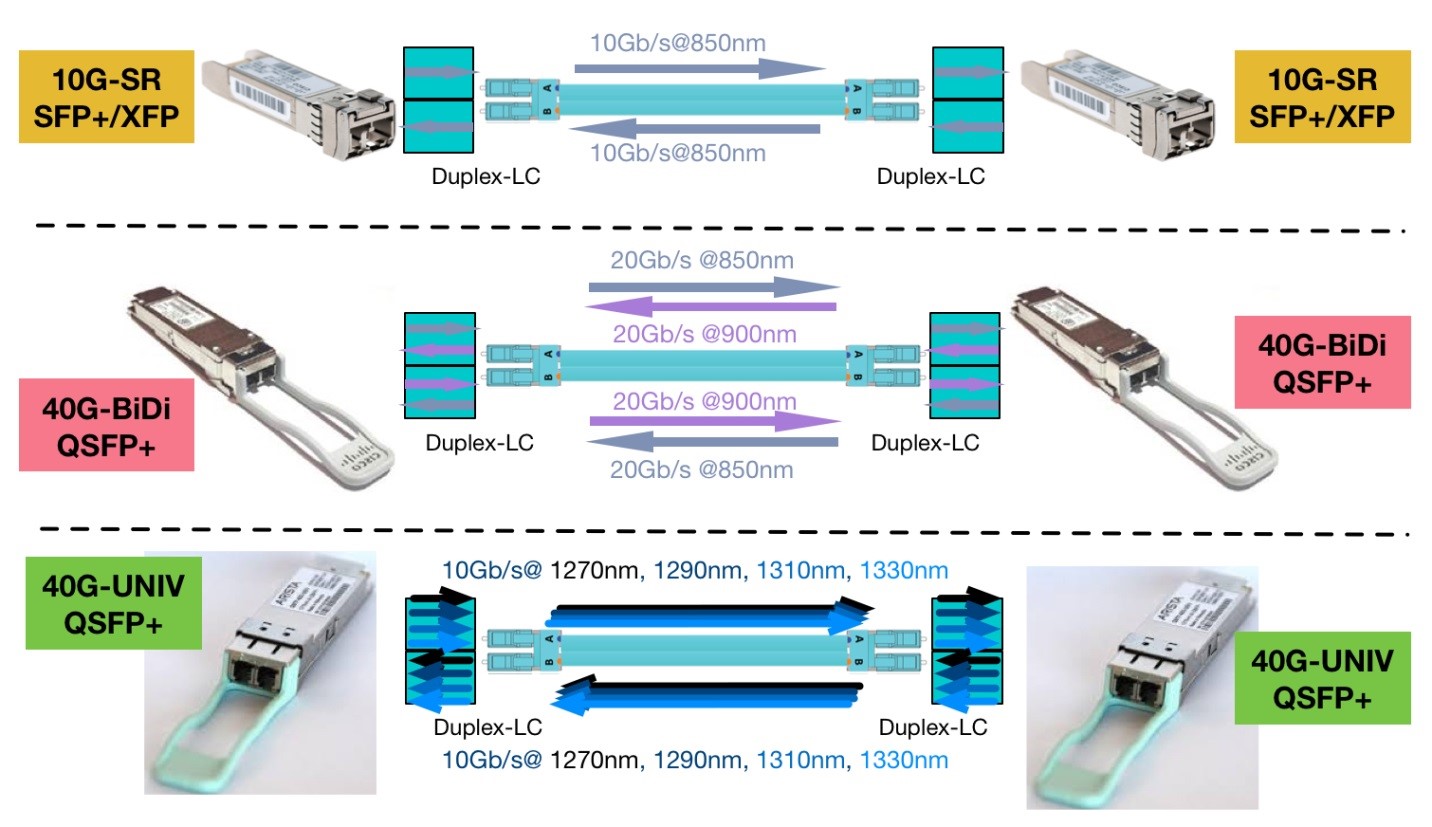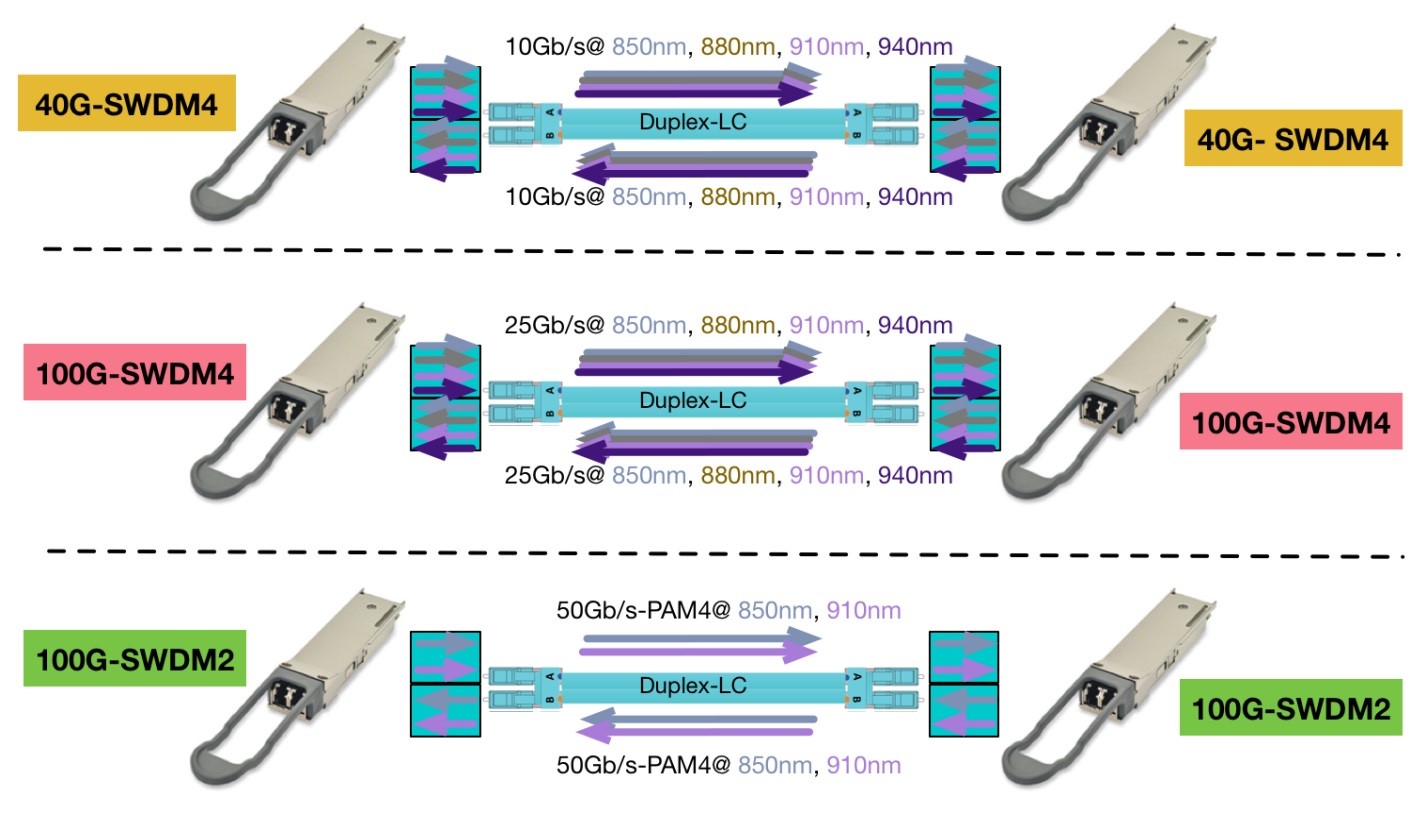A Cost-Effective Solution: Short Wavelength Division Multiplexing (SWDM)
The cloud ecosystem keeps growing. New IT applications, IoT and imminent 5G network deployment are all driving factors, and will likely require data center network infrastructure upgrades for many enterprises – and you can bet that these upgrades will involve, tedious tasks that require careful planning, testing, procurement and coordinated deployment efforts.
Since 2015, many Tier 1 hyperscale data centers have adopted singlemode fiber optics due to growing bandwidth requirements and expanding data center footprints. Giant public cloud service providers tend to use cost-optimized, non-IEEE-standard transceivers, such as PSM4 and CWDM4, which best suit their data center architectures and applications.
These providers also have very high buying power to acquire parts built their own specs. For example, Facebook publicly announced that it would accept a transceiver lifetime of five years instead of 20 years as an industry standard; it also operates its data center within a relaxed operating temperature range (e.g. 15°C to 55°C) instead of the industry-standard indoor 0-70°C.
Tier-2 and Tier-3 data center speed migration will still likely follow IEEE standards or multi-source agreements (MSAs) developed by industry consortiums. These products can be procured from multiple vendors with industry-wide deployment guidance. Currently, the migration from 1G to 10G in the access network, and from 10G to 40G in the core network, is ongoing or imminent in many enterprise and colocation data center spaces. Multimode optics continue to be the most suitable solution for such applications, supporting link distances of up to 400m.
In a previous blog, we discussed wideband multimode fiber (WBMMF) characteristics and its dedicated application: short wavelength multiplexing (SWDM). OM5 is the newly decided nomenclature for WBMMF, based on the specification in the TIA-492AAAE WBMMF standard developed by TIA-TR.42.
Applications Currently Using SWDM
Considering fiber infrastructure costs, parallel multimode MPO cabling is significantly more costly than LC-duplex fiber patch cords. For direct port-to-port connections, it’s more desirable to use a single fiber pair instead of MPO trunk to keep costs low.
To support smooth migration from 10G to 40G Ethernet, Cisco released a proprietary 40G bi-directional (BiDi) transceiver solution that allows reuse of the duplex multimode fiber pair for 40G connection. The BiDi transceiver employs two wavelengths (850nm and 900nm) transmitting in the same fiber on opposite directions, with an actual bit rate of 20 Gbps. It can support 40G data transmission up to 150m in OM4 multimode fiber.
Arista’s 40G universal transceiver is another solution that supports LC-duplex fiber pair instead of MPO cabling. The 40GBASE-UNIV can support a reach of 500m singlemode fiber and 150m reach in OM4. Similar solutions are available from Juniper (40G-LX4) and Finisar (40G-LM4).
In short-reach datacom applications, BiDi and Universal transceiver solutions have proven to be market successes.

10G SFP+, Cisco 40G QSFP+ BiDi and Arista 40G QSFP+ Universal transceivers
New SWDM Applications in WBMMF
Historically, compared to singlemode transceivers, multimode transceivers are lower in cost and more efficient in power consumption. The introduction of wideband multimode fiber will maintain the appeal of multimode fiber cabling systems for next-generation Ethernet speed implementation with SWDM technology.
Since the introduction of 40G Ethernet, QSFP has become the most popular form factor for 40G and 100G Ethernet physical interfaces. Recently, new SWDM-based QSFP multimode transceivers, including 40G-SWDM4, 100G-SWDM4 and 100G-SWDM2, have been demonstrated by a few vendors, as shown below.

SWDM transceivers in WBMMF
In regard to standardization, the SWDM4 consortium built a consensus that 4-wavelength is a viable solution, and it’s possible to support up to eight wavelengths in the single MMF. In the IEEE 802.3 working group, WBMMF was already taken into consideration for new standards development.
If you opt for SWDM transceivers in your next data center deployment, we recommend taking a close look at OM5 to support desired reach and link performance.
SWDM Uncertainty
Despite the potential advantages of the OM5 and SWDM solution, there are some factors to keep in mind:
- The SWDM ecosystem is not mature. OM5 cannot support higher modal bandwidth; therefore, the actual bandwidth gain over OM4 at 850nm wavelength is still unclear.
- To support 40G/100G migration with the installed base fiber cabling system, network equipment vendors are working closely with OEM transceiver suppliers. Currently, WBMMF has not been adopted widely as a general cabling solution.
- Transceiver complexity, power consumption and final costs can be potential hurdles for SWDM transceiver adoption.
- Compared to a parallel fiber solution, SWDM is less flexible; it doesn’t support breakout configuration that has been used extensively in short-reach cabling systems.
- Singlemode fiber has gained great traction in hyperscale data centers thanks to its boundless bandwidth and ability to support a few generations of speed upgrades. It is still unclear whether Tier 2 and Tier 3 data centers can benefit from the same cost and deployment advantages.
As an exciting new fiber type with wide wavelength coverage, OM5 is a good addition to the multimode fiber product family for the industry; it opens the door for SWDM at 840nm to 953nm. Users experience a reduction in fiber count and fiber cabling costs for next-generation speed migration; however, unlike the upgrade path from OM3 to OM4, which is a simple decision that leads to higher speed and longer reach, WBMMF will only be beneficial with transceivers that use multiple wavelengths.
Currently, emerging SWDM transceivers compete with existing proprietary BiDi and Universal transceivers, and with new middle-reach singlemode transceivers, such as PSM4, CWDM4 and CLR4.
Want to learn more about this topic? We’re working on a white paper that will provide you with more details about preparing for SWDM. Sign up to receive our updates so you don’t miss it!
